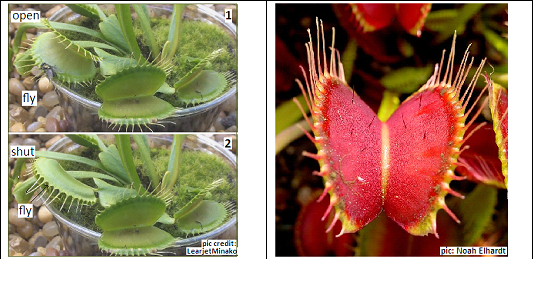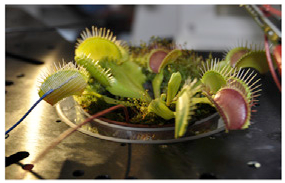There is clockwork that drives the action of insect eating plants, says S.Ananthanarayanan.
The Venus Flytrap, or Dionea Muscipula, left Charles Darwin spellbound by its ability to sense, capture and digest small creatures, to supplement the nutrients it received from its depleted habitat. That a plant, which is usually lower in the food chain, can turn carnivorous was indeed testimony to the potency of evolution.
The Venus Flytrap is native to South and North Carolina in the US and is usually found in swamps and bogs, areas that are typically poor in nitrogen and phosphorus. Nitrogen is vital for plant growth, particularly for synthesis of chlorophyll, and hence the need for a plant which cannot fond nitrogen in the soil to look for other sources. A team of researchers from institutes in Germany, and also Australia, Madrid and Riyadh report in the journal, Current Biology their study of the mechanism and sequence of events in the remarkable adaptation of Venus Flytrap in providing for metabolic nitrogen by the digestion of animal tissue.
The Venus Flytrap is a small plant which consists of four to seven leaves that branch out from a short stem, almost at the root. The leaves start out as a heart shaped, base portion that receives sunlight and carries out photosynthesis, but the true leaf is a pair of lobes that are joined in the midrib. The inner surface of the lobes is covered with a gluey substance called mucilage, which has a fruity odour, and attracts small insects. The surface also contains fine, hinged sensors, which are the trigger-hairs, which cause the two lobes to snap shut, to trap the insect when an insect touches them. The action is that light movement of the sensors sets off an electrical Action Potential, a short electrical burst of discharge of electricity by the movement of charged ions within cells at the base of the hairs. The effect is similar to the passing of signals by nerve cells which cause the flexing of muscle tissue in animals. The result is that the two lobes snap shut within a fraction of a second and capture the insect.

This snapping shut of the lobes is one of the fastest movements in the plant kingdom. How this comes about has long remained a mystery and explanations of Action Potential induced loss of fluid pressure, etc. have been unsatisfactory. But high speed photography studies of the closing lobes have shown that it comes about by the relaxing of elastic tension of a concave surface that has been stretched into a convex shape, as suggested in the picture. The edges of the lobes also have larger hairs which act as a barrier to prevent the escape of larger prey. The idea, however, as we shall soon see, is that smaller prey should get away.

A special feature of the snap-shut reaction of the lobes is that it does not occur at the first touch of the trigger hairs – it happens at the second, if the second touch comes within 15-20 seconds. The reason is one of economy, to be sure that any action taken would be purposeful - one contact with a trigger hair can happen without an insect being there – it could be a dew-drop for instance – it does not make sense to activate an energy expensive arrangement where there may be no reward. But if the same hair is touched twice, or another hair is disturbed within a short time, then, there is no sense in waiting, and the trap snaps shut.
A special feature of the snap-shut reaction of the lobes is that it does not occur at the first touch of the trigger hairs – it happens at the second, if the second touch comes within 15-20 seconds. The reason is one of economy, to be sure that any action taken would be purposeful - one contact with a trigger hair can happen without an insect being there – it could be a dew-drop for instance – it does not make sense to activate an energy expensive arrangement where there may be no reward. But if the same hair is touched twice, or another hair is disturbed within a short time, then, there is no sense in waiting, and the trap snaps shut.
The Current Biology researchers made actual measurements of electrical impulses arising from touch of the trigger hairs by attaching a light silver contact to the outer surface of the Flytrap lobe. When experimental, 6-12 mm crickets were exposed to the trap, it was seen that the lobes snapped shut at the second electrical pulse and then the pulses continued over sixty times after that, as the insect struggled.

Apart from the electrical activity, effects of mechanical force or stimulus on plants are well known. Root cells, for instance, grow around obstacles and the tendrils of climbing plants are able to sense shape and fashion growth to gain support. These responses are the result of synthesis of a substance called jasmonic acid (JA) as soon as there is touch of a category of cells. As there have also been studies that show that there is an increase in JA derived substances soon after prey capture by the Venus Flytrap, the Current Biology group simulated prey capture by mechanical stimulation of trigger hairs and monitored the levels of JA derivatives and also the tissue decomposing and nutrient transporting enzymes and agents in the ‘green stomach’ created by the Flytrap.
The group observed that the level of activity, which amounts to nutrient gathering investment by the plant, increases according to the drumbeats of trigger hair stimulation by the struggling insect. While there is no secretion of digestive fluids till the third AP, continued stimulation increases the closing of the lobes, till the cavity is sealed airtight. And as the insect keeps struggling, the quantity of juices secreted, including agents to transport nutrients, increases, to deal with the larger prey.
------------------------------------------------------------------------------------------